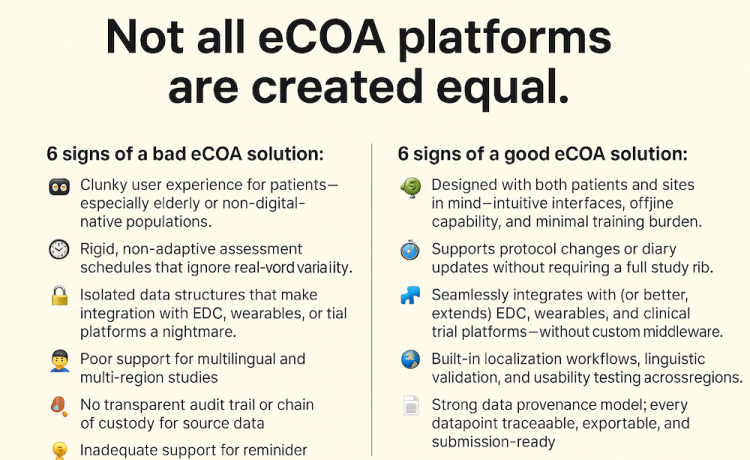We’ve seen the same mistakes in eCOA that plague other eClinical areas—products shaped more by pitch decks than by protocol realities.
If you’re evaluating an eCOA vendor, check whether the solution avoids the following six pitfalls, and demonstrates the six attributes of a mature, fit-for-purpose platform:
6 signs of a bad eCOA solution:
📱 Clunky user experience for patients
Too many eCOA platforms assume that patients are tech-savvy, fluent in English, and comfortable navigating apps. In reality, clinical trials span all ages, geographies, and digital abilities. A poor UI/UX leads to low compliance, high dropout rates, and untrustworthy data. The interface must be designed to accommodate visual impairments, limited dexterity, and minimal digital literacy.
🕒 Rigid, non-adaptive assessment schedules
Unlike EDC systems, eCOA typically works off a time- or event-based schedule. Bad systems fail to adjust to real-world deviations—like patients missing a scheduled entry, traveling across time zones, or changing routines. A rigid eCOA can’t support delayed or backdated entries, flexible reminder windows, or protocol-specific timing logic.
🔐 Isolated data structures
eCOA data is most powerful when it sits within a broader clinical ecosystem—alongside EDC, IRT, wearables, and DCT components. Poor platforms keep data locked in proprietary formats or require complex middleware to integrate. This results in inconsistent data views, version control problems, and increased cost and delay during database lock or submission.
🧠 Poor multilingual and regional support
Global trials demand systems that handle linguistic nuance, regional formatting (dates, times, units), and cultural expectations. Bad eCOA systems rely on literal translations without validation, ignore script differences (e.g., RTL languages), or fail to comply with country-specific guidelines. This weakens data integrity and risks non-compliance.
🪞 No transparent audit trail or chain of custody
eCOA data is source data. It must have clear, inspectable provenance. Systems that fail to log user/device metadata, can’t track changes or retractions, or lack submission-grade export formats put sponsors at regulatory risk. Every data point should have a verifiable path from patient to submission.
🎗️ Inadequate reminder and compliance support
Missing assessments are a major source of data loss. Poor platforms offer little or no support for intelligent reminders or escalation. They can’t respond to inactivity with site or call-centre support, nor can they adapt reminders based on participant behaviour. Compliance suffers, and so does trial power.
6 signs of a good eCOA solution:
🧠 Designed with both patients and sites in mind
A good eCOA platform is usable by all patients, regardless of age or digital familiarity. It should support offline use (where a protocol demands), include accessibility features (e.g., large fonts, audio), and minimise clicks. For sites, it should provide easy tracking of compliance and troubleshooting, plus support for re-training and remote resolution.
🧱 Supports protocol changes without full rebuilds
Mid-study protocol amendments are common. Good eCOA platforms allow diary or logic changes to be introduced through controlled workflows—without revalidating the whole system or disrupting existing data. Version management should be clear, traceable, and non-destructive.
🧹 Seamless integration with EDC, wearables, and CT platforms
The best eCOA systems fit into a modern tech stack without needing bespoke connectors. They offer open APIs (not pay to play), standards-based exports (e.g., CDISC ODM), and can both push and pull data in near real-time. Ideally, they extend existing systems like EDC rather than duplicating effort.
🌍 Built-in localisation and validation workflows
Translation isn’t enough. Good platforms come with linguistic validation pipelines, multi-script support, and region-aware configuration. They enable rapid deployment across countries without sacrificing accuracy or compliance, and they ensure versioned source documents for submission.
📜 Strong data provenance and traceability
Every data point should be timestamped, linked to device/user metadata, and stored in a secure, inspectable format. The platform should support data locking, query workflows, and export packages ready for regulatory review. Data integrity is not optional—it’s central.
📚 Reusable library of standardised instruments
A mature platform doesn’t reinvent the wheel. It provides a curated, validated library of ePROs, diaries, and psychometric scales, ready for deployment. This reduces build time, ensures standardisation, and improves comparability across studies and sponsors.
Final thoughts
We need eCOA tools that elevate both data quality and patient experience. That means depth, not just demos.
For founders and product teams: If you’re building in this space, I’m happy to share thoughts on how to get it right
Click here to book a 30 minute slot with Doug Bain.
Discover more from ClinFlo Consulting
Subscribe to get the latest posts sent to your email.

